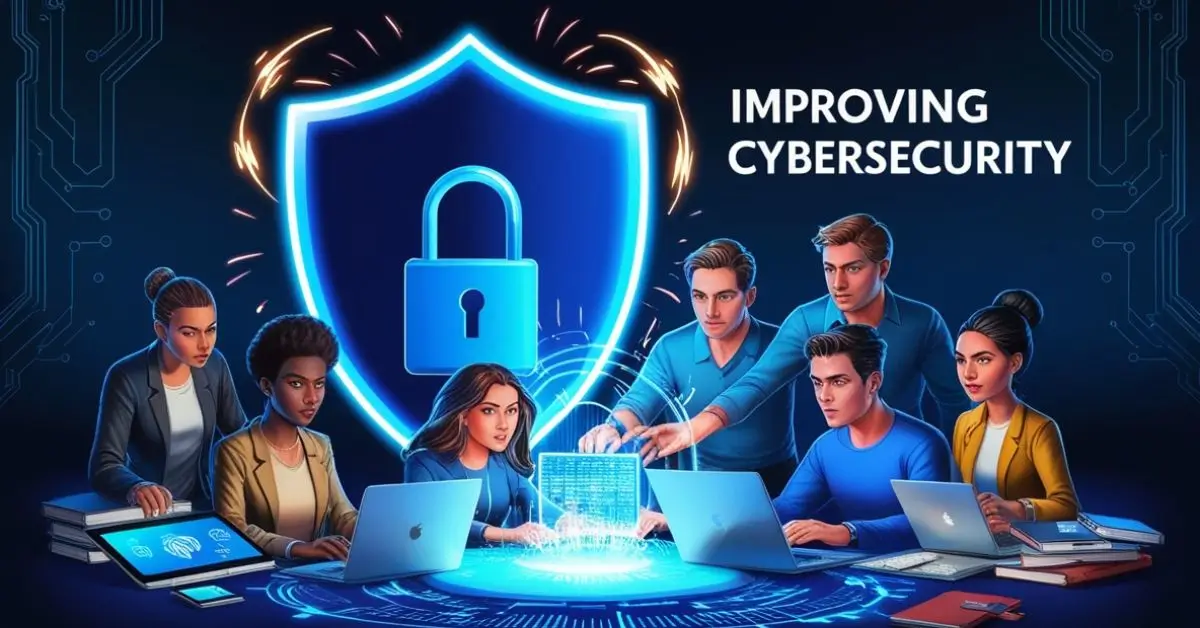In a world increasingly driven by technology, cybersecurity has become more important than ever. Every day, individuals, businesses, and governments are exposed to a wide range of cyber threats that can compromise their data, disrupt their operations, or even lead to financial losses. High-profile cyber-attacks, like those on major corporations and government entities, serve as stark reminders of the need for robust cybersecurity measures. This article explores effective strategies for improving cybersecurity at individual, organizational, and national levels.
Understanding Cybersecurity Threats
Before diving into cybersecurity improvements, it’s essential to understand the landscape of cyber threats that necessitate these measures. Cyber threats are malicious actions that target digital networks, systems, or data, with the goal of causing harm, stealing information, or holding it for ransom. Key types of cyber threats include:
- Malware: Malicious software like viruses, trojans, ransomware, and spyware are designed to harm systems, steal data, or encrypt files for ransom. Malware can infiltrate devices via phishing emails, untrusted downloads, or compromised websites.
- Phishing: Phishing scams are social engineering attacks that trick users into disclosing sensitive information, such as passwords or credit card numbers, often by posing as trusted entities.
- Denial of Service (DoS) and Distributed Denial of Service (DDoS) Attacks: These attacks flood systems with excessive traffic, causing them to slow down or crash, thus disrupting access to services.
- Insider Threats: Employees or contractors with access to sensitive information can pose risks, either intentionally or unintentionally.
- Advanced Persistent Threats (APTs): APTs involve continuous, targeted cyber-attacks on organizations to steal data or disrupt operations. These are often sophisticated and difficult to detect.
With cyber threats constantly evolving, improving cybersecurity is critical for safeguarding data and ensuring business continuity.
Best Practices for Individuals
On a personal level, there are several best practices individuals can adopt to protect their data and devices from cyber threats:
- Use Strong, Unique Passwords: Using complex passwords is one of the most effective ways to safeguard accounts. Avoid simple passwords, and never reuse passwords across different platforms. Password managers can help store and generate strong passwords for each account.
- Enable Two-Factor Authentication (2FA): Two-factor authentication provides an additional layer of security, requiring a secondary verification method like a code sent to a mobile device. This protects accounts even if passwords are compromised.
- Regular Software Updates: Keeping operating systems, applications, and antivirus software up-to-date is essential. Software updates often include security patches that protect against newly discovered vulnerabilities.
- Beware of Phishing Scams: Individuals should be cautious of unsolicited emails, texts, or social media messages that ask for personal information or encourage them to click on suspicious links. Learning to identify phishing messages is a critical skill in cybersecurity.
- Use a Secure Wi-Fi Network: Securing home Wi-Fi by changing default router passwords and using WPA3 encryption can prevent unauthorized access. Avoid using public Wi-Fi for sensitive activities; if necessary, use a VPN.
- Limit Personal Information Sharing: Social media and other platforms can expose personal data that hackers may use for attacks. Adjusting privacy settings and sharing information cautiously can mitigate these risks.
By adopting these measures, individuals can significantly reduce their vulnerability to cyber-attacks and protect their sensitive data.
Best Practices for Organizations
For businesses, cybersecurity best practices are more extensive and involve a combination of technology, policies, and employee training:
- Implement a Robust Cybersecurity Framework: Organizations should adopt cybersecurity frameworks, such as the NIST Cybersecurity Framework or ISO 27001, which provide structured approaches to managing and reducing cyber risks.
- Regular Employee Training: Employees are often the first line of defense in cybersecurity. Training sessions on topics like phishing, secure password practices, and incident reporting help employees recognize threats and respond appropriately.
- Data Encryption: Encrypting data in transit and at rest makes it unreadable to unauthorized users. Encryption ensures that even if data is intercepted, it remains secure.
- Access Control and Privilege Management: The principle of least privilege (PoLP) limits users’ access to the minimum data necessary for their role. Role-based access control (RBAC) can also be implemented to restrict access based on job function, reducing the risk of data breaches.
- Network Security Measures: Firewalls, intrusion detection systems (IDS), and intrusion prevention systems (IPS) are vital tools that monitor, detect, and prevent unauthorized access to network resources.
- Incident Response and Disaster Recovery Plans: Having a structured incident response plan helps organizations respond to cyber incidents effectively. Disaster recovery plans, including regular data backups, enable organizations to restore operations quickly in case of a cyber-attack.
By implementing these practices, organizations can create a more resilient cybersecurity environment that protects their data and minimizes potential damage from cyber threats.
Technological Solutions and Tools
Technology plays a significant role in improving cybersecurity. The following tools and technologies can help individuals and organizations bolster their defenses:
- Antivirus and Anti-Malware Software: These software solutions detect and block malicious programs before they can harm devices or steal data. They are a fundamental defense against malware attacks.
- Virtual Private Networks (VPNs): VPNs encrypt internet connections, making data transmitted over networks harder to intercept. They are especially useful on public Wi-Fi networks.
- Firewall Protection: Firewalls act as a barrier between internal networks and external threats, blocking unauthorized traffic and preventing access to potentially harmful sites.
- Intrusion Detection and Prevention Systems (IDPS): IDPS monitor network traffic for suspicious activity and can prevent unauthorized access. They’re essential in identifying unusual behavior that may signal a cyber-attack.
- Security Information and Event Management (SIEM): SIEM software collects and analyzes security-related data in real-time, allowing organizations to identify and respond to potential threats.
- Artificial Intelligence (AI) and Machine Learning (ML) in Cybersecurity: AI and ML are increasingly used in cybersecurity to detect anomalies, predict potential attacks, and respond to threats in real-time, reducing the need for manual monitoring.
These tools provide additional layers of defense, improving an organization’s ability to detect and respond to cyber threats promptly.
The Role of Cybersecurity Policies
Effective cybersecurity requires well-defined policies that provide guidelines for managing data, protecting privacy, and responding to incidents:
- Developing a Cybersecurity Policy: An organization’s cybersecurity policy should cover essential elements, including access control, data protection, and incident response. It provides a framework for handling cybersecurity issues consistently.
- Enforcing Policies Consistently: Policies should be enforced across all levels of the organization. Regular reviews and audits help ensure compliance with the policies and identify areas for improvement.
- Privacy Policy for Customer Data: Protecting customer data is crucial for maintaining trust. A comprehensive privacy policy outlines how customer data is collected, used, and protected, ensuring compliance with data protection laws.
Clear and consistent cybersecurity policies not only protect data but also provide a foundation for building a strong security culture within organizations.
Legal and Ethical Aspects of Cybersecurity
Cybersecurity is not only about technology; it also involves legal and ethical considerations that guide how data is protected and used.
- Cybersecurity Regulations and Compliance: Laws like GDPR (General Data Protection Regulation), CCPA (California Consumer Privacy Act), and HIPAA (Health Insurance Portability and Accountability Act) require organizations to protect customer data and follow strict data handling practices.
- The Ethics of Cybersecurity: Balancing security measures with respect for individual privacy rights is essential. Ethical cybersecurity practices prevent the misuse of surveillance and data collection technologies.
- Staying Informed on Legal Developments: Cybersecurity laws and regulations are constantly evolving to address new threats. Organizations must stay updated to ensure compliance and avoid potential penalties.
Legal and ethical practices not only help avoid regulatory penalties but also build trust with customers, who can be confident their data is handled responsibly.
Cybersecurity for Small Businesses and Startups
Small businesses often face unique challenges in cybersecurity due to limited budgets and resources. However, they can still implement basic measures to protect their data and assets:
- Challenges Unique to Small Businesses: Small businesses may lack the resources for extensive cybersecurity measures, making them attractive targets for cybercriminals.
- Affordable Cybersecurity Measures: Small businesses can prioritize essential measures like regular backups, antivirus protection, and firewalls. Many of these solutions are affordable and provide critical protection.
- Employee Training on a Budget: Small businesses can take advantage of online resources and affordable training programs to educate employees on best cybersecurity practices.
With the right strategies, small businesses can build a strong cybersecurity foundation that protects their operations without straining resources.
The Future of Cybersecurity: Trends to Watch
As technology advances, so do cyber threats. Here are some cybersecurity trends that are shaping the future:
- Zero Trust Security Models: Zero trust security models assume that all network activity is potentially harmful, requiring strict verification for access. This model minimizes risks from insider threats and unauthorized access.
- Increased Automation: Automation is reducing the time required for detecting and responding to cyber threats, improving cybersecurity efficiency.
- Blockchain for Security: Blockchain technology provides a secure, decentralized way of storing data, which could improve data integrity and reduce the risk of tampering.
- Quantum Computing: While quantum computing holds promise, it also poses risks for current encryption methods. Cybersecurity professionals are exploring quantum-resistant encryption techniques to address this threat.
- Cybersecurity as a Service (CSaaS): Many organizations are turning to managed cybersecurity services for expertise and resource efficiency, especially smaller firms with limited IT staff.
The future of cybersecurity will involve adapting to these new developments and integrating them into comprehensive defense strategies.
Conclusion
Cybersecurity is an essential component of modern life, protecting our data and ensuring the smooth functioning of systems and networks. From strong passwords to comprehensive cybersecurity policies, there are numerous ways to improve digital security at every level. The rapid evolution of cyber threats requires individuals, organizations, and governments to continuously adapt their strategies, utilizing the latest technologies and best practices. By implementing these measures, we can build a safer digital environment for everyone.











